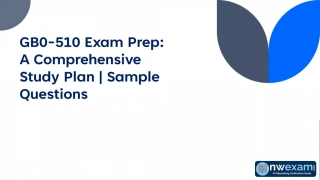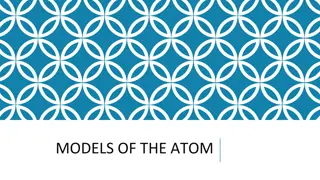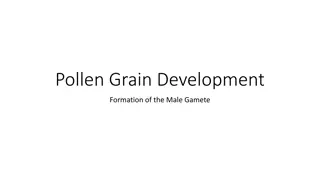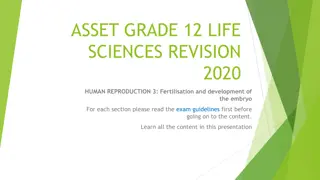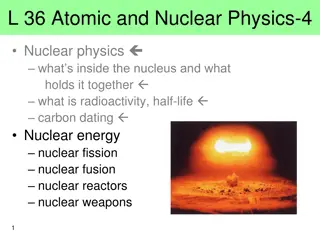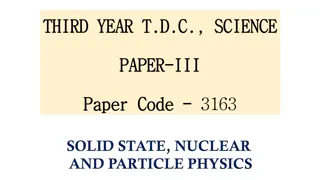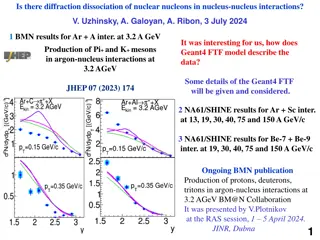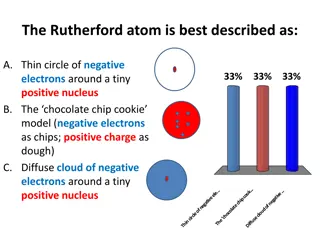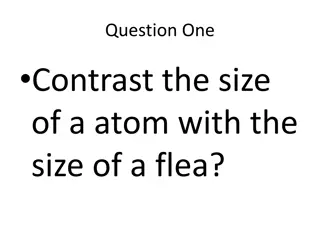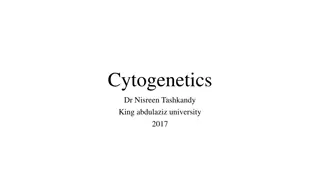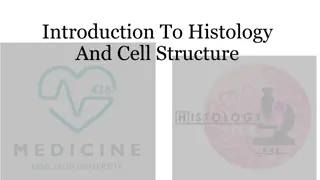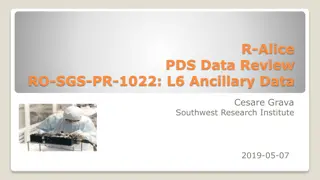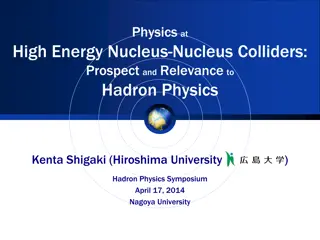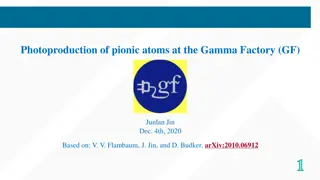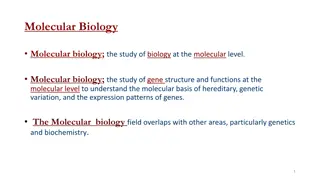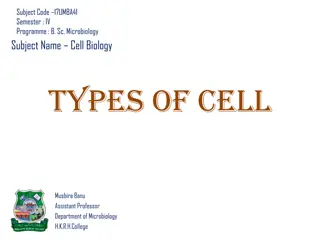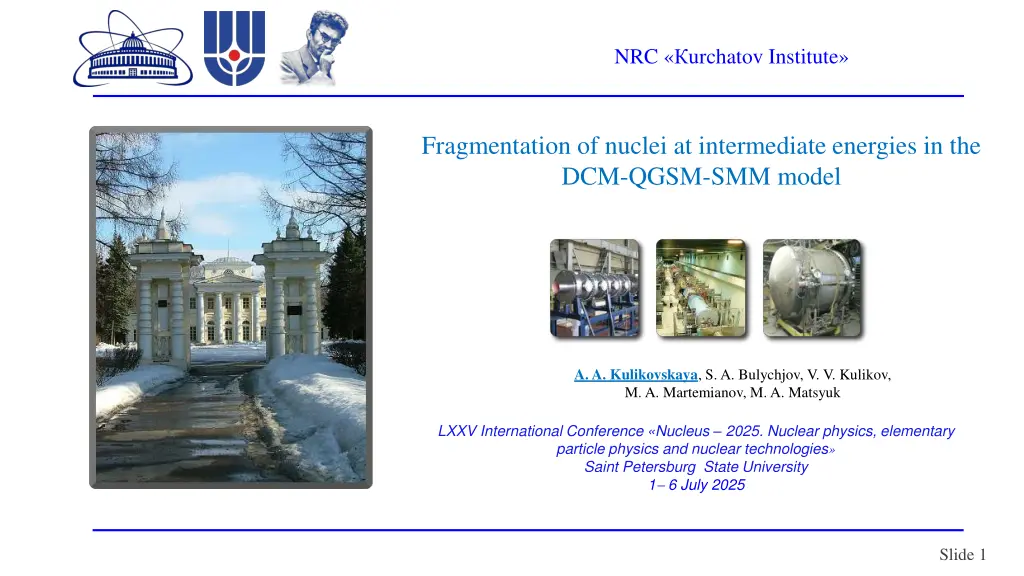
Nucleus-Nucleus Interactions at Intermediate Energies
Explore the DCM-QGSM-SMM model for the fragmentation of nuclei at intermediate energies, focusing on nucleus-nucleus interactions. Learn about the DCM-QGSM and DCM-QGSM-SMM models, their applications in experimental setups, and the simulation of nucleus collisions. Dive into the advanced features of the DCM-QGSM-SMM model, including multifragmentation and hyperfragments production. Discover the development and applicability of these models in nuclear physics research.
Download Presentation

Please find below an Image/Link to download the presentation.
The content on the website is provided AS IS for your information and personal use only. It may not be sold, licensed, or shared on other websites without obtaining consent from the author. If you encounter any issues during the download, it is possible that the publisher has removed the file from their server.
You are allowed to download the files provided on this website for personal or commercial use, subject to the condition that they are used lawfully. All files are the property of their respective owners.
The content on the website is provided AS IS for your information and personal use only. It may not be sold, licensed, or shared on other websites without obtaining consent from the author.
E N D
Presentation Transcript
NRC urchatov Institute Fragmentation of nuclei at intermediate energies in the DCM-QGSM-SMM model A. A. Kulikovskaya, S. A. Bulychjov, V. V. Kulikov, M. A. Martemianov, M. A. Matsyuk LXXV International Conference Nucleus 2025. Nuclear physics, elementary particle physics and nuclear technologies Saint Petersburg State University 1 6 July 2025 Slide 1
Introduction Among the significant tasks in the physics of heavy nucleus, it should be note the creation and development of models of nucleus-nucleus interactions. Currently, the DCM-QGSM-SMM model is supported and actively developed, which is based on the unification of the Dubna Cascade Model (DCM-QGSM) and the Statistical Model of Multifragmentation (SMM) It is designed to provide computer simulations for the new BMN and MPD experimental setups at the NICA heavy ion accelerator complex and covers a wide range of colliding nuclei and energies The report examines the applicability of this model to the experimental data obtained during fragmentation of nuclei on different targets of the FRAGM experimental setup and TWAC accelerator complex at intermediate energies. This setup allows recording the resulting fragments at an angle of 3.50relative to the initial beam A comparison of the model's predictions is given both with data from other experiments and with the results obtained within the framework of various models of nucleus-nucleus interactions (BC, INCL) Codes and programs to generate events within the DCM-QGSM and DCM-QGSM-SMM models were kindly provided to us by Genis Musulmanbekov (JINR). Slide 2
DCM-QGSM model of nucleus-nucleus interaction DCM-QGSM (Dubna Cascade Model Quark Gluon String Model) is a Monte Carlo approach used to simulate nucleus collisions in a wide energy region DCM is a universal intranuclear cascade model to describe lepton, hadron and nucleus-nucleus interactions. Cascade particles produced in primary binary interactions then passage through both the target and projectile nuclei producing in turn new secondary particles. This model has been proposed for over thirty years at JINR [V. D. Toneev, K. K. Gudima, Nucl. Phys. A400, 173 (1983) ] and has energy limitations up to 4.5 GeV To make the DCM code applicable at higher energies, it was merged with the QGSM model. QGSM simulating elementary hadron collisions describes binary collisions in the framework of independent quark-gluon strings quasiclassical approximation After the cascade stage of reaction, the coalescence model is applied. It produced light nuclei, such as2H,3H,4He etc., by final state interactions among emitted cascade nucleons Then the processes of fission and evaporation of excited remnants are occurring correspondingly. The remnants undergo processes like evaporation, fission, or fragmentation depending on their energy states and configurations Recently, DCM and QGSM have formed the basis of other nuclear-nuclear collision models, which, however, are not publicly available Slide 3
DCM-QGSM-SMM model of nucleus-nucleus interaction DCM-QGSM-SMM (Dubna Cascade Model Quark Gluon String Model Statistical Multifragmentation Model) is an advanced version of DCM-QGSM model operating in a wide energy region for both light and heavy nuclei New physics phenomena are implemented in the corresponding model: extended coalescence, multifragmentation, and hyperfragments production SMM model is used after the completion of the cascade stage to describe highly excited fragments and heavy ions. It is assumed that in this case a nucleus with a high excitation energy decays into a large number of clusters and free nucleons. In this model, the probabilities of different decay channels are proportional to their statistical weights [J. P. Bondorf, A. S. Botvina, A. S. Iljinov, I. N. Mishustin, Phys. Rep. 257, 133 (1995) ] SMM has an advantage over the previous model of Fermi breakup, which considered the decay of only light remnants In our analysis, it was used the current model and SMM model independently to study the influence of excitation energy to the final momentum shape of light fragments This model has sufficient advantages over other similar models of nucleus-nucleus interactions, since it is applicable and gives satisfactory results in a wide range of both energies and colliding nuclei On the other hand, the current model is under active development and modification, so it needs to be tested on data to identify both its advantages and disadvantages Slide 4
Experimental data obtained using the FRAGM setup Data were collected on accelerator-storage complex TWAC (Terra Watt ACcumulator) at12 fragmentation with energies of 300, 600, 950, 2000, 3200 MeV/nucleon, and also at 56Fe with energy of 230 MeV/nucleon Fragmentation processes was carried out on different targets:9Be, 27Al,64Cu, 181Ta [B.M. Abramov et al., J. Phys. Conf. Ser. 798, 012077 (2017)] The magneto-optical channel is adjusted to a certain rigidity selected for current data taking run.All fragments are detected at angle equal to 3.5 0.50 2Dim correlation distribution: TDC (TOF function of the atomic mass number, measured between CF1 and C2) vs QDC (function of dE/dx and Z of fragment defined by counter CF1), TDC channel = 0.2 ns Our results are presented in the form of the differential cross sections d2 /(dpd ) as function of the laboratory momentum or inv= (E/p2) d2 /(dpd ) in the rest frame of the projectile Experimental data are renormalized on the model prediction to obtain final results, so therefore, an accurate model description of the fragmentation processes is required for our measurements [A. A. Kulikovskaya et al., Phys. Atom. Nucl. 85, 9, 1541 (2022)] Slide 5
Light fragments from 12C fragmentation at 0.3 GeV/nucleon Good correlation distributions Differential cross section d2 /(dp d ) for data are in a good agreement with DCM-QGSM and models for light fragments Heavier fragments described differently in various models and data separation of fragments by DCM-QGSM-SMM production are d2 /(dpd ), mb/(MeV/c sr) 12 fragmentation on 9Be target at T0 = 300 MeV/nucleon Slide 6
production from 12C fragmentation at 3.2 GeV/nucleon Satisfactory separation of +from protons; has no additional background Differential cross section distribution for as a function of its laboratory momentum demonstrate both: fragmentation region in the peak and cumulative one in the high momentum region demonstrating a downward slope. The experimental data align well with model calculation in the fragmentation region Ratio of / +yields demonstrates a good agreement between experimental data and predictions above 1.5 GeV/c; below this region the influence of the Coulomb effect becomes significant [B.M. Abramov et al., Phys. Atom. Nucl. 84, 4, 467 (2021); Yad. Fiz. 84, 4, 331 (2021) 4, 331] production Slide 7
56Fe fragmentation as test of the momentum shapes / I DCM-QGSM-SMM:56Fe fragmentation at T0= 230 MeV/nucleon Detector FRAGM acceptance LAQGSM model with Au Au interactions at ? = 11.5 GeV/nucleon 4He < 0.01 . neutrons protons 2H Plots shows distribution of inv. as function of momentum in the rest frame of incident nucleus in comparison with theoretical calculated by the Statistical Multifragmentation Model (SMM) (provided to us byA. S. Botvina) Profile of this distribution can defined the proper and satisfactory parameters of the exited projectile In the case of asymmetrical fission the predictions p / z, GeV / peak profile of momentum has a double- humped structure This It s clear seen, that this effect can play effect is associated with the an important role under designing charged influence of the Coulomb field of the particles detectors to measure the luminosity residual nucleus [B.M. Abramov et al., EPJ Web Conf. 204, 03008 (2019)] Slide 8
56Fe fragmentation as test of the momentum shapes / II The splitting effect is observed for light fragments up to4He It s clearly seen, that the double-humped peak structure decreases with increasing fragment mass number All models of nucleus-nucleus collisions demonstrate the same behavior These models exhibit peak splitting, although they show different magnitudes of this effect Slide 9
Fragmentation of light nuclei at different energies Plots demonstrate d /d as function of the projectile energy during the fragmentation of 12C on 9Be target for thee light fragments at an angle equal to 3.50 The behavior and magnitude of the experimental data are in satisfactory FRAGM acceptance agreement with models especially in the lower energy region At higher energies the difference between the models and corresponding data becomes more significant This effect differences in is associated with angular distributions, which is more clearly seen for energy equal to 2 GeV/nucleon Slide 10
12C fragmentation at 400 MeV/nuculeon (FIRST/GSI setup) Experimental obtained from tation on energy of 400 MeV/nucl. data are 12C fragmen- 197Au target with Experiment was carried out with the FIRST setup and SIS (heavy ion synchrotron) at GSI: [M. Toppi et al., Phys. Rev. C 93, 064601 (2016)] FIRST can detect fragments at low angles below ~ 50(this limitation is due to the gap in the setup magnet) and gives data in d /d values Comparison of data with model predictions satisfactory looks Slide 11
Fragmentation of 12C on different targets Graphs show d /d distribution as a function of the target mass for12C 181Ta 64Cu fragmentation at energy 300 MeV/ 27Al 9Be nucleon The data are presented for light ions registering at an angle of 3.5 . The BC model predictions are used as a norma- lization factor It is seen that the data are in good agreement with the predictions of both DCM-QGSM and DCM-QGSM-SMM models. For heavier nuclei, there is less pronounced agreement between the data and the model predictions Slide 12
Charge-exchange reactions at 12C fragmentation (I) (II) (II) Charge-exchange reactions are accompanied by a change in charge while maintaining the atomic mass. At 12 fragmentation such processes are accompanied by the12B or12N production. DCM-QGSM-SMM includes this new type of reactions which are not included in DCM-QGSM Typically, such reactions are described using binary interactions of the Quasi-elastic process Inelastic process projectile and target nucleons using quasi-elastic (I) and inelastic (II) interactions, the latter being accompanied by the baryon resonances generation (I) (I) Experimental data from the FRAGM on production of12B at12 fragmentation at small angle 3.50 and energy 300 (I) (I) (II) (II) MeV/nucleon with comparison of the model predictions Slide 13
Conclusion Two models of nucleus-nucleus collisions DCM-QGSM and its subsequent modification DCM-QGSM-SMM were considered. These models, which combine the advantages of the cascade model and statistical multifragmentation, are intended to describe fragmentation processes for both a wide range of colliding nuclei and a wide range of energies The main focus of this report is on the FRAGM experiment carried out on TWAC accelerator complex, where data were obtained for nuclear fragments produced at different energies and on different targets ( Be, Al, Cu, Ta), measured at an angle of 3.50. The data obtained for light fragments are in good agreement with model predictions for light nuclei In general, the experimental data of the FRAGM setup on pion production also demonstrate good agreement between the model and experimental data The influence of the Coulomb field of the residual nucleus on the shapes of the momentum spectra of light nuclei was investigated at the fragmentation of the56Fe nucleus as a result of the asymmetric fission To study the angular distributions, data from the FIRST/GSI experiment on the fragmentation of12C with an energy of 400 MeV/nucleon were used The analysis performed demonstrates the reliability and validity of the DCM-QGSM-SMM model for data analysis at intermediate energies. At the same time, there are some discrepancies between our data in the region of heavier fragments, including the inconsistency of the presented models at high energies Slide 14
Thank you for attention Slide 15

